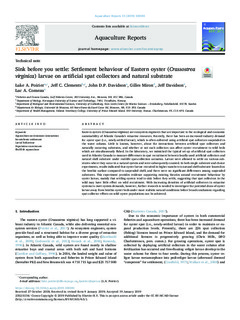| dc.description.abstract | Eastern oysters (Crassostrea virginica) are ecosystem engineers that are important to the ecological and economic sustainability of Atlantic Canada’s estuarine resources. Recently, there has been an increased industry demand for oyster spat (i.e., newly-settled larvae), which is often collected using artificial spat collectors suspended in the water column. Little is known, however, about the interactions between artificial spat collectors and naturally occurring substrates, and whether or not such collectors can affect oyster recruitment to wild beds which are simultaneously fished. In the laboratory, we mimicked the typical set-up of artificial spat collectors used in Atlantic Canada to measure differences in spat recruitment between locally-used artificial collectors and natural shell substrate under real-life spat-collection scenarios. Larvae were allowed to settle on various substrates where they occur in a natural system and were subsequently counted. In both single substrate and choice experiments, results indicated that oyster larvae recruited in higher numbers to natural shell substrate located on the benthic surface compared to suspended shell; and there were no significant differences among suspended substrates. This experiment provides evidence supporting existing theories around recruitment behaviour by oyster larvae, mainly that settling oysters tend to sink before they settle, suggesting that spat collectors in the wild may have little effect on wild recruitment. With increasing densities of artificial collectors in estuarine systems to meet system demands, however, further research is needed to investigate the potential draw of oyster larvae away from benthic oyster beds under more realistic natural conditions before broad conclusions regarding spat collector effects on wild oyster populations can be achieved. | nb_NO |

